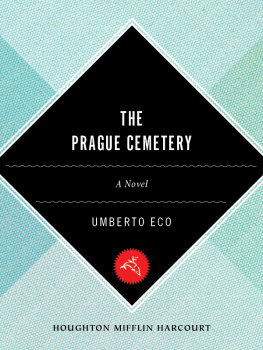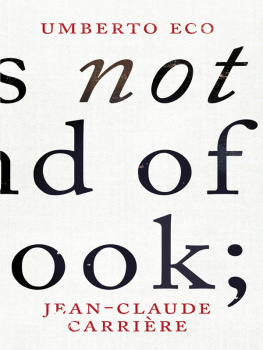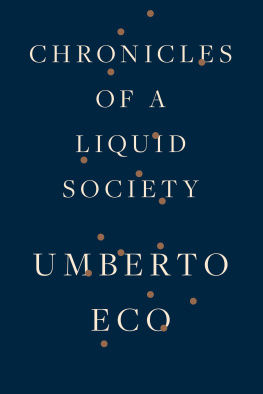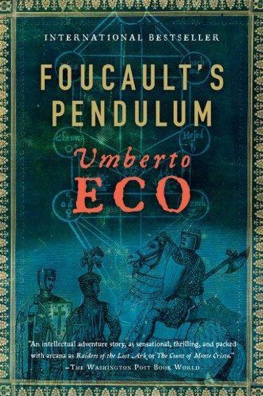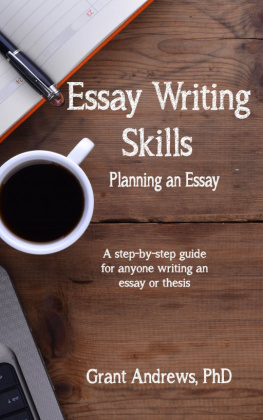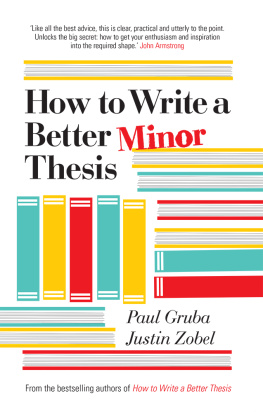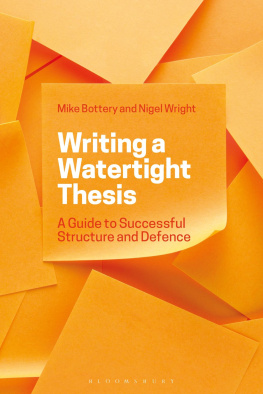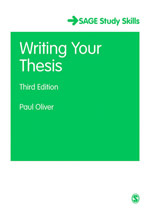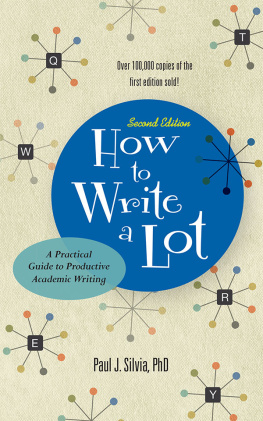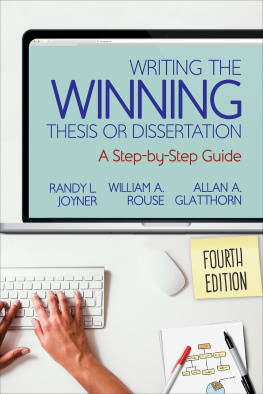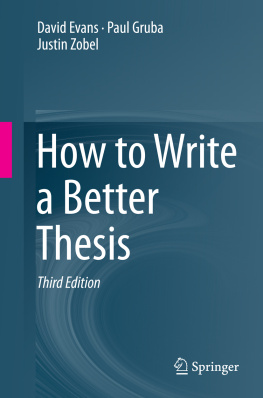How to Write a Thesis
How to Write a Thesis
Umberto Eco
translated by Caterina Mongiat Farina and Geoff Farina
foreword by Francesco Erspamer
The MIT Press
Cambridge, Massachusetts
London, England
2015 Massachusetts Institute of Technology
Translated from the original Italian, Come si fa una tesi di laurea: le materie umanistiche, 1977/2012 Bompiani/RCS Libri S.p.A., Via Angelo Rizzoli 8 20132 Milano
All rights reserved. No part of this book may be reproduced in any form by any electronic or mechanical means (including photocopying, recording, or information storage and retrieval) without permission in writing from the publisher.
MIT Press books may be purchased at special quantity discounts for business or sales promotional use. For information, please email special_sales@mitpress.mit.edu.
This book was set in Chapparal Pro by the MIT Press. Printed and bound in the United States of America.
Library of Congress Cataloging-in-Publication Data is available.
isbn : 978-0-262-52713-2
10 9 8 7 6 5 4 3 2 1
Contents
1.1 What Is a Thesis, and Why Is It Required?
1.2 For Whom Is This Book Written?
1.3 The Usefulness of a Thesis after Graduation
1.4 Four Obvious Rules for Choosing a Thesis Topic
2.1 Monograph or Survey?
2.2 Historical or Theoretical?
2.3 Ancient or Contemporary?
2.4 How Long Does It Take to Write a Thesis?
2.5 Is It Necessary to Know Foreign Languages?
2.6 Scientific or Political?
2.6.1 What Does It Mean to Be Scientific?
2.6.2 Writing about Direct Social Experience
2.6.3 Treating a Journalistic Topic with Scientific Accuracy
2.7 How to Avoid Being Exploited by Your Advisor
3.1 The Availability of Primary and Secondary Sources
3.1.1 What Are the Sources of a Scientific Work?
3.1.2 Direct and Indirect Sources
3.2 Bibliographical Research
3.2.1 How to Use the Library
3.2.2 Managing Your Sources with the Bibliographical Index Card File
3.2.3 Documentation Guidelines
3.2.4 An Experiment in the Library of Alessandria
3.2.5 Must You Read Books? If So, What Should You Read First?
4.1 The Table of Contents as a Working Hypothesis
4.2 Index Cards and Notes
4.2.1 Various Types of Index Cards and Their Purpose
4.2.2 Organizing the Primary Sources
4.2.3 The Importance of Readings Index Cards
4.2.4 Academic Humility
5.1 The Audience
5.2 How to Write
5.3 Quotations
5.3.1 When and How to Quote: 10 Rules
5.3.2 Quotes, Paraphrases, and Plagiarism
5.4 Footnotes
5.4.1 The Purpose of Footnotes
5.4.2 The Notes and Bibliography System
5.4.3 The Author-Date System
5.5 Instructions, Traps, and Conventions
5.6 Academic Pride
6.1 Formatting the Thesis
6.1.1 Margins and Spaces
6.1.2 Underlining and Capitalizing
6.1.3 Sections
6.1.4 Quotation Marks and Other Signs
6.1.5 Transliterations and Diacritics
6.1.6 Punctuation, Foreign Accents, and Abbreviations
6.1.7 Some Miscellaneous Advice
6.2 The Final Bibliography
6.3 The Appendices
6.4 The Table of Contents
\
Foreword
How to Write a Thesis was first published in 1977 in Italy, where it has remained in print ever since. Not only has the book provided instruction and inspiration for generations of Italian students, but it has been translated into seventeen languages, including Persian (1996), Russian (2001), and Chinese (2003). Remarkably, given the books success, in an era when editorial facelifts, sequels, and new editions have become publishing norms, the book has not been revised or updated, apart from an augmented introduction that Umberto Eco wrote for the 1985 edition. Its durable rules and sound advice have remained constant, despite passing trends and changing technologies.
I am not sure whether this qualifies it as a classic. A classic, Italo Calvino wrote, is a work which relegates the noise of the present to a background humbut without rendering that hum inaudible. Indeed, at first glance, this book may seem incompatible with our present, considering that chapter 6 is typewritten rather than word-processed (with underlining to render italics!) and that chapter 4 includes reproductions of index cards with handwritten corrections and additions. As unfamiliar as this way of taking notes may be to todays students, it evokes nostalgic memories for those of us who attended college before the 1990s. The persistence of How to Write a Thesis is not due to nostalgia, however, nor do I think it is because it renders the noise of the present remote. I believe the books staying power has to do with the very essence of the humanities.
The humanities are not a body of texts, objects, and information that we inherited from the pasteither a remote past or one so recent that we perceive it as our present, although as soon as we examine it we understand that it is irrevocably gone. The humanities are the process of preservation and appropriation of that pastness , a process that requires specific skills acquired through practice, as all skills are. This book teaches a techne , in the Greek sense of applied and context-related knowledgea sort of craftsmanship. This is why its title is not, say, What Is a Thesis? , an ontological question. Its avowed objective, the thesis, is actually less important than the occurrence of writing it, of making it: how to write a thesis. Umberto Eco takes us back to the original purpose of theses and dissertations as defining events that conclude a program of study. They are not a test or an exam, nor should they be. They are not meant to prove that the student did his or her homework. Rather, they prove that students can make something out of their education.
This is particularly important today, when we are more accustomed to thinking in compliance with the software of our laptop or doing research according to the logic of a tablet than to thinking and researching in a personal and independent way. Written in the age of typewriters, card catalogs, and writing pads, How to Write a Thesis is less about the final outcome than about the path and method of arriving there. For Aristotle, knowledge was pursued for its own sake, and such a pursuit could be justified only by an instinctive drive and the intellectual pleasure generated by the fulfillment of that instinct. For Kant, aesthetics and judgment were based on disinterestedness: they could not be programmed, only experienced. The humanities are intrinsically creative and innovative. They are about originality and invention, not discovery. This is precisely Ecos testimony; even more than a technical manual, this book is an invitation to ingenuity, a tribute to imagination.
By exposing twenty-first-century students to long-established practices of scholarly research, this book will introduce them to the core skills that constitute the writing of a thesis: finding an important and intriguing topic, being thorough, taking pride in ones work, giving thoughts time to develop, identifying with a subject, and being resourceful in locating information about it. That is exactly what this book did for me, as a student and young scholar. How to Write a Thesis was first published just as I was beginning to think about writing my own thesis, and it was from the Italian edition of this book ( Come si fa una tesi di laurea ) that I learned how to choose a topic, how to look for sources and prepare a bibliography, how to use my librarys research systems, how to organize and prioritize information, and finally how to write a captivating and professional dissertation. It remained an indispensable reference source to me for years, long after I had defended and published my thesis. When I began working at the University of Rome, I recommended it to my own students. Many professors in Italy today still refer their students to it, and many university websites in other countries quote long passages from the book as part of the protocol for students to become familiar with before they write a thesis.
Next page


